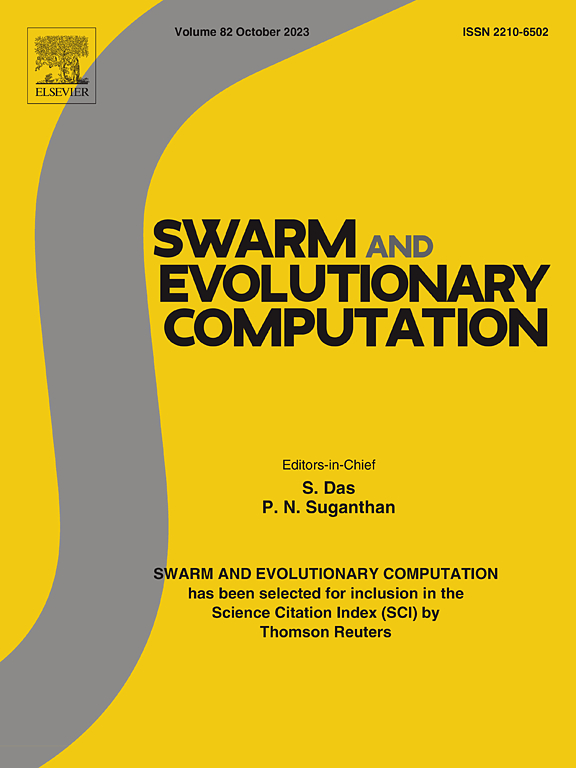基于代理模型的深度卷积神经网络中高维超参数的高效配置
IF 8.2
1区 计算机科学
Q1 COMPUTER SCIENCE, ARTIFICIAL INTELLIGENCE
引用次数: 0
摘要
深度卷积神经网络分类中超参数配置的合理性直接决定了其性能。深度卷积神经网络在配置高维超参数进行分类时,如何有效地降低高计算成本并保证分类性能是一个挑战。本文提出了一种基于深度卷积神经网络中高维超参数的高效组态方法,用于代理模型辅助分类。通过设计渐进式累积dropout神经网络代理模型(PA-Dropout),动态测量了超参数配置对多性能目标的贡献,并进行了迭代筛选。结果表明,PA-Dropout算法对深度卷积神经网络中高维超参数配置与多目标性能之间关系的拟合效率得到了提高。考虑高维超参数构型个体收敛多样性的综合评价和自适应加权计算,设计了一种双驱动交互式动态模型管理策略(DDIDMMS)。为真实评估提供了可靠的候选解,从而提高了PA-Dropout的更新效率。最后,实现了深度卷积神经网络中用于分类的高维超参数的有效配置。通过多达100个决策变量和20个目标的DTLZ和WFG基准问题,以及实际的分类任务,验证了该方法在解决分类任务CNN高维超参数配置的昂贵多目标优化问题时的优越性和泛化性。本文章由计算机程序翻译,如有差异,请以英文原文为准。
Efficient configuration of high-dimensional hyperparameters in deep convolutional neural networks for classification assisted by surrogate models
The rationality of hyperparameter configuration in deep convolutional neural networks for classification directly determines its performance. It is challenging to reduce high computational costs effectively and guarantee performance in the configuration of high-dimensional hyperparameters in deep convolutional neural networks for classification. This paper proposes an efficient configuration method that concerns high-dimensional hyperparameters in deep convolutional neural networks for classification assisted by surrogate models. By designing a progressive accumulation dropout neural network surrogate model (PA-Dropout), the contribution of hyperparameters configurations to multi-performance objectives is dynamically measured and then the contribution is iteratively screened. As a result, the fitting efficiency of the PA-Dropout to the relationship between high-dimensional hyperparametric configurations and the multi-objective performance in deep convolutional neural networks for classification with scarce data is improved. A dual-drive interactive dynamic model management strategy (DDIDMMS) is designed, considering the comprehensive evaluation and adaptive weighting calculation of convergence diversity of high-dimensional hyperparametric configuration individuals. Reliable candidate solutions are provided for real evaluation, thereby improving the update efficiency of PA-Dropout. Finally, an efficient configuration of high-dimensional hyperparameters in deep convolutional neural networks for classification is realized. By using DTLZ and WFG benchmark problems with up to 100 decision variables and 20 targets, as well as practical classification tasks, the superiority and generalization of this method are verified when solving the expensive multi-objective optimization problem of CNN high-dimensional hyperparameter configuration for classification tasks.
求助全文
通过发布文献求助,成功后即可免费获取论文全文。
去求助
来源期刊

Swarm and Evolutionary Computation
COMPUTER SCIENCE, ARTIFICIAL INTELLIGENCEC-COMPUTER SCIENCE, THEORY & METHODS
CiteScore
16.00
自引率
12.00%
发文量
169
期刊介绍:
Swarm and Evolutionary Computation is a pioneering peer-reviewed journal focused on the latest research and advancements in nature-inspired intelligent computation using swarm and evolutionary algorithms. It covers theoretical, experimental, and practical aspects of these paradigms and their hybrids, promoting interdisciplinary research. The journal prioritizes the publication of high-quality, original articles that push the boundaries of evolutionary computation and swarm intelligence. Additionally, it welcomes survey papers on current topics and novel applications. Topics of interest include but are not limited to: Genetic Algorithms, and Genetic Programming, Evolution Strategies, and Evolutionary Programming, Differential Evolution, Artificial Immune Systems, Particle Swarms, Ant Colony, Bacterial Foraging, Artificial Bees, Fireflies Algorithm, Harmony Search, Artificial Life, Digital Organisms, Estimation of Distribution Algorithms, Stochastic Diffusion Search, Quantum Computing, Nano Computing, Membrane Computing, Human-centric Computing, Hybridization of Algorithms, Memetic Computing, Autonomic Computing, Self-organizing systems, Combinatorial, Discrete, Binary, Constrained, Multi-objective, Multi-modal, Dynamic, and Large-scale Optimization.
 求助内容:
求助内容: 应助结果提醒方式:
应助结果提醒方式:


